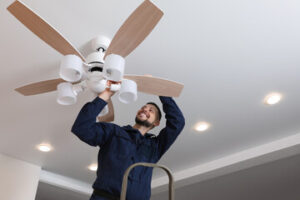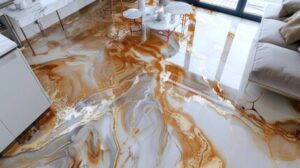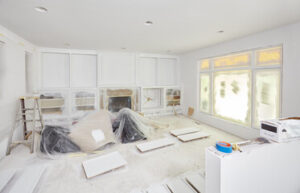Ceilings Perth play a crucial role in shaping how rooms are used and perceived. High ceilings can make homes feel spacious and regal, while lower ceilings can create a cozier and more intimate ambiance.

Conventional ceilings are flat, low-cost, and easy to install. They can be finished with a variety of textures to add visual interest.
Coffered ceilings are an architectural feature that can provide a sense of dimensionality and grandeur to a room. They typically incorporate a grid of beams, or coffers, that creates recessed panels. These panels are often decorated with a variety of different finishes and moldings, which can help add texture and design interest to the ceiling. The term “coffer” actually means indentation, and the specific shape of those indentations can vary widely. Some coffered ceilings are square, rectangular or octagonal while others may be more elaborate in their design.
Although coffered ceilings are typically seen as a traditional element, they can also be used in modern spaces to add elegance and sophistication. The geometric patterns of the recessed panels are often accented by recessed lighting, which can further enhance the visual impact of these ceilings.
A coffer ceiling can be created using a variety of materials, including wood or plaster. Depending on the desired style, these ceilings can be finished in rough-hewn wood to convey a rustic feel or ornate plasterwork for a Baroque-inspired space. In addition to bringing a sense of depth and dimension to a room, these ceilings can also serve a practical purpose by helping reduce noise levels and allowing for the concealment of structural elements, such as pipes or wires that cannot be removed or relocated.
Despite their complexity, coffered ceilings are not difficult to construct for homeowners who are familiar with the process. The standard method involves the use of a set of main base beams, which are usually built perpendicular to existing ceiling joists. The sides of these beams are then wrapped with pieces of bead casing, which is glued and nailed to the joists to create the appearance of intersecting beams.
For homeowners who are unsure of how to incorporate a coffered ceiling into their home, a professional can usually offer advice on the most effective approach. The contractor can also help ensure that the design will work well with the room’s dimensions and existing furniture, as well as advise on which type of molding will best complement the ceiling.
Beamed Ceilings
A beamed ceiling is another way to add depth, character, and architectural appeal to a living space. The look varies in style depending on the type of ambiance you want to create, whether it’s rustic warmth or a sleek modern aesthetic. The type of material used for the beams also affects how well the design integrates with your home’s aesthetic and how much it will cost to install.
Beams are a classic architectural feature that have been around for centuries and can be made from wood, stone, or a combination of materials. They can be painted, stained, or embellished with extra moldings or details for added flair. If you’re concerned about the expense of a real-wood beam, faux beams are a great alternative that mimic the appearance of aged, weathered timber.
Using the same basic construction techniques as traditional ceiling beams, these options can be installed as a standalone structure or integrated into an existing flat ceiling. They can be designed to cleverly conceal ductwork or wiring, ensuring they add beauty without compromising a room’s structural integrity.
A wood beam ceiling can work beautifully in rustic, farmhouse, or country homes, creating a cozy, welcoming atmosphere. If you’re seeking a more formal feel, this style also complements traditional and transitional styles thanks to its timeless elegance. The natural texture of these wooden beams blends easily with a neutral color palette, creating a harmony between rough and refined materials.
In a contemporary space, exposed beams can be a statement feature that enhances a lofty open floor plan and showcases your home’s unique design. They can be trimmed with recessed lighting or a grid of decorative insets to illuminate the space while adding visual interest.
For a truly stunning ceiling, you can incorporate both wooden and faux beams to create an eye-catching combination of textures that celebrates techniques from the past. This design element is particularly effective in open living spaces that can support the drama of a vaulted or coffered ceiling.
A beamed ceiling can enhance the ambiance of any living space, transforming it into a place where you want to spend time. The key to integrating this design element is understanding your personal style and how it can complement the beam pattern you choose. Larger rooms can handle more intricate layouts, such as a coffered ceiling, while smaller spaces can benefit from the simplicity of parallel or perimeter beams.
Coved Ceilings
Cove ceilings are the perfect accent to any home design, whether traditional or modern. Often overlooked or not even considered when remodeling, this ceiling style adds an element of architectural sophistication to any room. In addition, the beauty of a coved ceiling allows homeowners to personalize their spaces without requiring costly crown moulding.
The defining characteristic of a coved ceiling is its rounded curved framing detail that connects your wall and ceiling. Unlike flat ceilings, which end at a hard 90-degree angle, this rounded transition creates a soft, seamless finish.
This unique ceiling option can be installed in a variety of ways, depending on your preference and your space. The most popular method is a top and bottom reveal, which features a smooth curve from the ceiling to the walls. The top edge of the cove can be raised by adding another piece of wood (or fur down) to form a step, or it can be made deeper and more pronounced. The bottom edge of the cove can also be made deeper or more pronounced, creating a stunning tray ceiling effect.
For a simpler look, you can also install a smooth coved ceiling without a reveal. This style is often used in new construction to create a seamless connection between your walls and ceiling, while removing the need for expensive crown molding.
Some homes may have a cove ceiling already in place, and if this is the case you will need to measure your curve radius and then select a preformed gypsum cove base. Cove base is available in a wide range of gauges and finishes, so you can find the perfect match for your existing ceiling. Some bases are even designed to hide imperfections in the drywall.
If you’re looking to make a bold statement with your ceilings, a stepped or tray ceiling is the way to go. With its dramatic curving shape, this ceiling will transform any room and highlight your design sense. The defining characteristic of this ceiling type is its curved transition from the wall to the ceiling, but it’s important to keep in mind that your ceiling can be as simple or as complex as you like.
Textured Ceilings
Though textured ceilings are sometimes considered outdated, they can still add character and charm to a room. They also hide imperfections in the drywall and offer sound control. They are available in many different styles, and some can be visually stunning. The type of texture you choose depends on your preferred style, maintenance needs, and noise control requirements.
The most popular drywall texture is orange peel, which is created by spraying a layer of drywall compound onto the ceiling. This slightly bumpy but soft-looking surface is a common choice for modern homes and business premises, offering the look of a textured ceiling while remaining easy to wipe clean. It’s also one of the most affordable drywall texture methods.
A skip trowel texture is an eye-catching option that creates a distinctive pattern. This texture looks similar to stucco and can be used to create an elegant Mediterranean-style aesthetic. The light reflects off of the peaks and depressions, creating a beautiful effect in well-lit rooms. Avid DIYers can apply this type of ceiling texture, although professional help is usually required for more complex textures.
Swirl ceilings combine elegance with artistry, giving your home a unique appearance. This texture is created by applying a thin layer of drywall compound and using a tool to create swirling patterns. The swirls can be uniform, or they can have small breaks in them for a more artistic design.
Another option is a spray sand ceiling texture, which uses sand mixed with the drywall compound to create a grainy look. This is often applied with a hopper gun or paint sprayer, but can also be applied by hand. It is often chosen for a casual and comfortable living space, adding warmth and comfort to the home. This type of texture is a good choice for homes with children because it masks smudges and drips more easily than smooth surfaces.
No matter which type of texture you choose, it’s important to prepare properly. Start by thoroughly cleaning the entire surface to remove any dirt, dust, or debris that could compromise the adhesion of your texture. Then, sand the area to remove any rough spots. Once the sanding is complete, prime the ceiling before applying your chosen texture.

